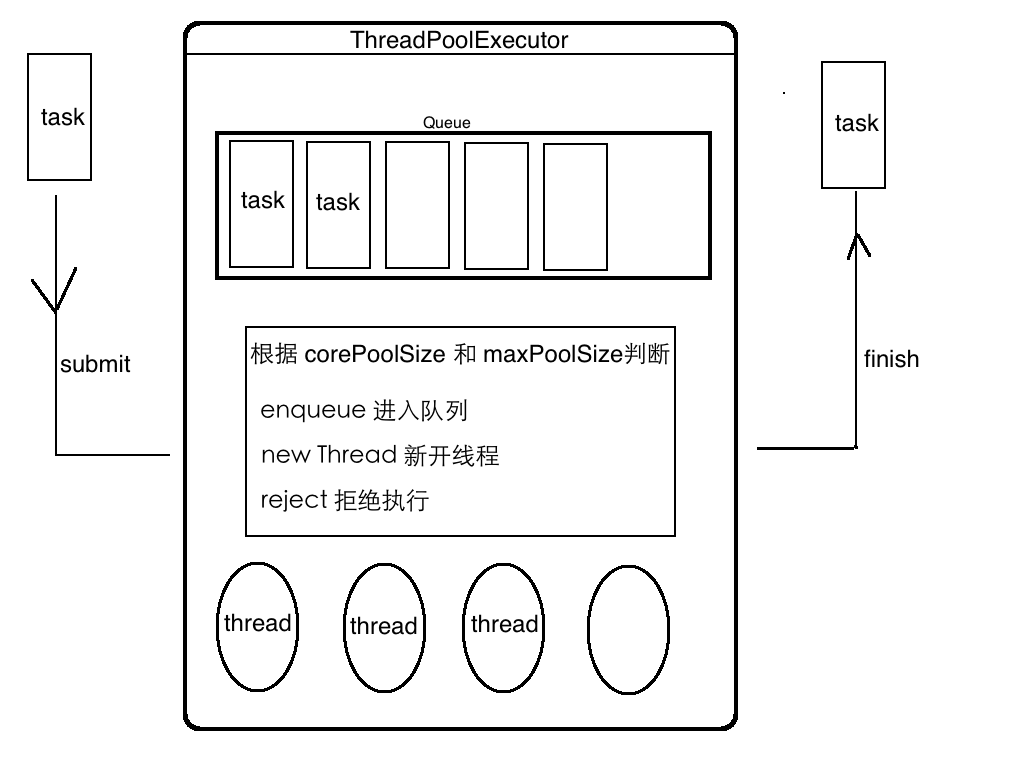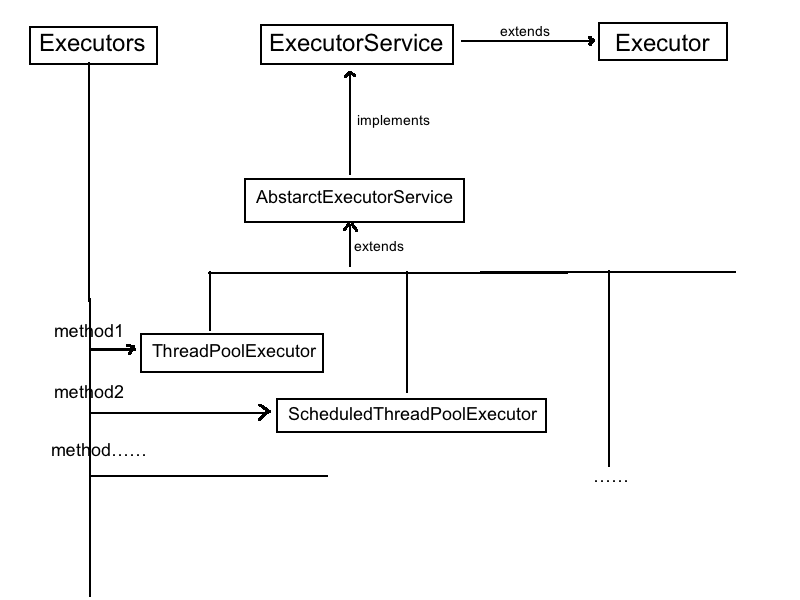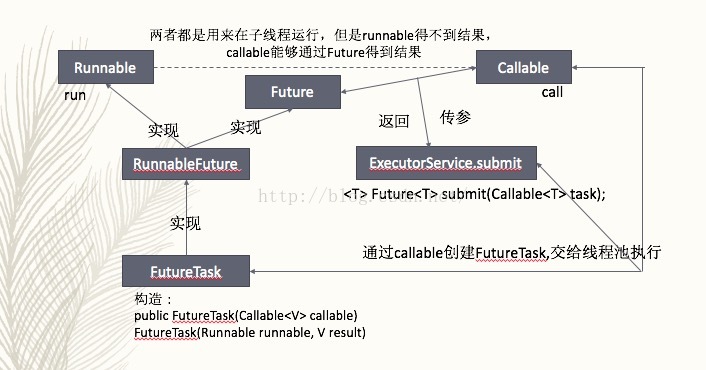本文主要是介绍(十) ExecutorService,希望对大家解决编程问题提供一定的参考价值,需要的开发者们随着小编来一起学习吧!
前言:上一篇FutureTask的执行过程中其实与ExecutorService有关,但是由于对这个知识点不是很熟,所以就略过了,现在专门就这个知识点学习一下。
参考博客:Java线程池 ExecutorService
demo地址:点击打开链接
1. ExecutorService的简单使用
简单地看了下ExecutorService的API,感觉还是适合一边看源码一边写例子比较靠谱,一上来就写个简单的例子热身一下。
package com.example.demo_10_executorservice;import android.support.v7.app.AppCompatActivity;
import android.os.Bundle;
import android.util.Log;import java.util.concurrent.Callable;
import java.util.concurrent.ExecutionException;
import java.util.concurrent.ExecutorService;
import java.util.concurrent.Executors;
import java.util.concurrent.Future;public class MainActivity extends AppCompatActivity {private static final String TAG = "simpleTest";@Overrideprotected void onCreate(Bundle savedInstanceState) {super.onCreate(savedInstanceState);setContentView(R.layout.activity_main);ExecutorService executorService = Executors.newFixedThreadPool(5);Future<Integer> future = executorService.submit(new Callable<Integer>() {@Overridepublic Integer call() throws Exception {int sum = 0;for(int i = 0; i< 10; i++){sum += i;}return sum;}});try {Log.d(TAG, "the sum is: " + future.get());}catch (InterruptedException | ExecutionException ex){ex.printStackTrace();}executorService.shutdown();}
}
简单来讲就是先新建一个大小为5的线程池,然后在里面执行一个计算0到10累加的任务,执行完毕以后将线程池关闭。(线程池建立看了下适合下一篇博客再写)
2. ExecutorService的继承关系
先拷贝一个总体上继承关系的图
本博客主要讲的ExecutorService就是继承的Executor接口,而ExecutorService本身自己也是一个接口。
2.1 Executor
先看下Executor:
* The {@code Executor} implementations provided in this package* implement {@link ExecutorService}, which is a more extensive* interface. The {@link ThreadPoolExecutor} class provides an* extensible thread pool implementation. The {@link Executors} class* provides convenient factory methods for these Executors.** <p>Memory consistency effects: Actions in a thread prior to* submitting a {@code Runnable} object to an {@code Executor}* <a href="package-summary.html#MemoryVisibility"><i>happen-before</i></a>* its execution begins, perhaps in another thread.** @since 1.5* @author Doug Lea*/
public interface Executor {/*** Executes the given command at some time in the future. The command* may execute in a new thread, in a pooled thread, or in the calling* thread, at the discretion of the {@code Executor} implementation.** @param command the runnable task* @throws RejectedExecutionException if this task cannot be* accepted for execution* @throws NullPointerException if command is null*/void execute(Runnable command);
}
从上面注释可以看出如下几点:
- ExecutorService是Executor更充分的实现
- Executors为线程池提供了便捷的工厂类(与Executor有关,但不是一回事)
- 一致性原则:任务提交总是在执行之前
- Executor只有void execute(Runnable command)一个方法
2.2 ExecutorService
ExecutorService本身是一个接口,它继承了Executor接口,并在此基础上进行了拓展。
public interface ExecutorService extends Executor3. API分析及实际使用
本文主要还是就ExecutorService的api进行学习,但是由于它只是个接口,所以不可避免选择一个具体的实现进行接口的实际使用,所以还是很粗糙很不全面的演示,本文主要是用的newFixedThreadPool;最好还是后面学习Executors及其生成的各种线程池再来回顾一下。
3.1 submit
submit方法主要就是用来提交单个任务执行的,并且返回一个代表任务执行结果的Future对象,可以调用Future的get()方法获取任务的执行结果。
/*** Submits a value-returning task for execution and returns a* Future representing the pending results of the task. The* Future's {@code get} method will return the task's result upon* successful completion.** <p>* If you would like to immediately block waiting* for a task, you can use constructions of the form* {@code result = exec.submit(aCallable).get();}** <p>Note: The {@link Executors} class includes a set of methods* that can convert some other common closure-like objects,* for example, {@link java.security.PrivilegedAction} to* {@link Callable} form so they can be submitted.** @param task the task to submit* @param <T> the type of the task's result* @return a Future representing pending completion of the task* @throws RejectedExecutionException if the task cannot be* scheduled for execution* @throws NullPointerException if the task is null*/<T> Future<T> submit(Callable<T> task);/*** Submits a Runnable task for execution and returns a Future* representing that task. The Future's {@code get} method will* return the given result upon successful completion.** @param task the task to submit* @param result the result to return* @param <T> the type of the result* @return a Future representing pending completion of the task* @throws RejectedExecutionException if the task cannot be* scheduled for execution* @throws NullPointerException if the task is null*/<T> Future<T> submit(Runnable task, T result);/*** Submits a Runnable task for execution and returns a Future* representing that task. The Future's {@code get} method will* return {@code null} upon <em>successful</em> completion.** @param task the task to submit* @return a Future representing pending completion of the task* @throws RejectedExecutionException if the task cannot be* scheduled for execution* @throws NullPointerException if the task is null*/Future<?> submit(Runnable task);
从上面的源码可以看出几点不一样的细节:
- 如果想立刻阻塞等待任务执行结果可以调用result = exec.submit(aCallable).get()
- <T> Future<T> submit(Runnable task, T result)已将任务结果写死了,不能像Callable一样返回result
- Future<?> submit(Runnable task)执行成功后返回的结果是Null
对应两个demo,源码即运行结果如下:
private void submit2(){ExecutorService executorService = Executors.newFixedThreadPool(5);Future<String> future = executorService.submit(new Runnable() {@Overridepublic void run() {Log.d(TAG, "do something");}}, "jiatai happy");try {Log.d(TAG, "the result of submit2 is: " + future.get());}catch (InterruptedException | ExecutionException ex){ex.printStackTrace();}executorService.shutdown();}private void submit3(){ExecutorService executorService = Executors.newFixedThreadPool(5);Future<?> future = executorService.submit(new Runnable() {@Overridepublic void run() {Log.d(TAG, "do something");}});try {Log.d(TAG, "the result of submit3 is: " + future.get());}catch (InterruptedException | ExecutionException ex){ex.printStackTrace();}executorService.shutdown();}运行结果:
03-11 11:07:37.740 6413-6413/com.example.demo_10_executorservice D/simpleTest: the result of submit1 is: 45
03-11 11:07:37.750 6413-6453/com.example.demo_10_executorservice D/simpleTest: do something
03-11 11:07:37.750 6413-6413/com.example.demo_10_executorservice D/simpleTest: the result of submit2 is: jiatai happy
03-11 11:07:37.752 6413-6459/com.example.demo_10_executorservice D/simpleTest: do something
03-11 11:07:37.752 6413-6413/com.example.demo_10_executorservice D/simpleTest: the result of submit3 is: null3.2 shutdown and shutdownNow
当我们使用完成ExecutorService之后应该关闭它,否则它里面的线程会一直处于运行状态。
举个例子,如果的应用程序是通过main()方法启动的,在这个main()退出之后,如果应用程序中的ExecutorService没有关闭,这个应用将一直运行。之所以会出现这种情况,是因为ExecutorService中运行的线程会阻止JVM关闭。
如果要关闭ExecutorService中执行的线程,我们可以调用ExecutorService.shutdown()方法。在调用shutdown()方法之后,ExecutorService不会立即关闭,但是它不再接收新的任务,直到当前所有线程执行完成才会关闭,所有在shutdown()执行之前提交的任务都会被执行。
如果我们想立即关闭ExecutorService,我们可以调用ExecutorService.shutdownNow()方法。这个动作将跳过所有正在执行的任务和被提交还没有执行的任务。但是它并不对正在执行的任务做任何保证,有可能它们都会停止,也有可能执行完成。
复制粘贴了一段,大概意思是说如果没有调用shutdown,有可能会导致内存泄露。
源码如下所示:
/*** Initiates an orderly shutdown in which previously submitted* tasks are executed, but no new tasks will be accepted.* Invocation has no additional effect if already shut down.** <p>This method does not wait for previously submitted tasks to* complete execution. Use {@link #awaitTermination awaitTermination}* to do that.*/void shutdown();/*** Attempts to stop all actively executing tasks, halts the* processing of waiting tasks, and returns a list of the tasks* that were awaiting execution.** <p>This method does not wait for actively executing tasks to* terminate. Use {@link #awaitTermination awaitTermination} to* do that.** <p>There are no guarantees beyond best-effort attempts to stop* processing actively executing tasks. For example, typical* implementations will cancel via {@link Thread#interrupt}, so any* task that fails to respond to interrupts may never terminate.** @return list of tasks that never commenced execution*/List<Runnable> shutdownNow();我对其他博客上的说法还是心存怀疑的,比较信服源码上的注释和我自己测试的结果,从上面的注释可以看出:
- shutdown原来是初始化一个有序的对已提交任务的关闭,但是不接受新的任务,如果线程池已经关闭了再次调用将没有影响
- 如果想要等待先前提及但还没执行完毕的任务,那么请调用awaitTermination
- shutdownNow会尝试停止所有活跃的正在执行的任务,暂停正在等待的任务,并且返回一个等待执行任务的集合。它不会等正在执行的任务完成。并且也不保证会停止正在执行的任务,和interrupt有异曲同工之妙。
下面就是写demo一个一个验证了。
3.2.1 验证shutdown
shutdown原来是初始化一个有序的对已提交任务的关闭,但是不接受新的任务,如果线程池已经关闭了再次调用将没有影响
shutdown自然会遇到4种情况
- 已经执行完的任务
- 正在执行的任务
- 正在等待执行的任务
- 已经调用shutdown后才提交的任务
所以写demo的时候最好是充分地考虑这种情况,API中对这四种情况说得不是很清楚。就我猜测:
- 对已经执行完的任务没有影响
- 对于正在执行的任务会等待任务执行完毕
- 对于正在等待执行的任务会取消执行
- 已经调用shutdown后才提及的任务是提交不了的
对应demo(task1 2 3 4分别和四种情况相对应):
private void shutdown1(){Log.d(TAG, "----shutdown1 begin---- ");ExecutorService executorService = Executors.newFixedThreadPool(1);Log.d(TAG, "----task1 begin---- ");Future future1 = executorService.submit(new Task1());Log.d(TAG, "----task2 begin---- ");Future future2 = executorService.submit(new Task2());try {Thread.sleep(500);} catch (InterruptedException e) {e.printStackTrace();}Log.d(TAG, "----task3 begin---- ");Future future3 = executorService.submit(new Task3());executorService.shutdown();Log.d(TAG, "----executorService.shutdown---- ");Future future4 = null;try {future4 = executorService.submit(new Task4());} catch (Exception e) {e.printStackTrace();} finally {}try {Log.d(TAG, "the result of shutdown1 is: " + future1.get());Log.d(TAG, "the result of shutdown1 is: " + future2.get());Log.d(TAG, "the result of shutdown1 is: " + future3.get());Log.d(TAG, "the result of shutdown1 is: " + future4.get());}catch (InterruptedException | ExecutionException ex){ex.printStackTrace();}catch (Exception ex){ex.printStackTrace();}Log.d(TAG, "----shutdown1 end---- ");}private class Task1 implements Callable<String>{@Overridepublic String call() throws Exception {int sum = 0;for(int i = 0; i< 10; i++){sum += i;}return "task1";}}private class Task2 implements Callable<String>{@Overridepublic String call() throws Exception {int sum = 0;for(int i = 0; i< 10; i++){sum += i;}Thread.sleep(2000);return "task2";}}private class Task3 implements Callable<String>{@Overridepublic String call() throws Exception {int sum = 0;for(int i = 0; i< 10; i++){sum += i;}Thread.sleep(2000);return "task3";}}private class Task4 implements Callable<String>{@Overridepublic String call() throws Exception {int sum = 0;for(int i = 0; i< 10; i++){sum += i;}Thread.sleep(2000);return "task4";}}对应运行结果:
03-11 11:46:54.034 13116-13116/? D/simpleTest: ----shutdown1 begin----
03-11 11:46:54.035 13116-13116/? D/simpleTest: ----task1 begin----
03-11 11:46:54.035 13116-13116/? D/simpleTest: ----task2 begin----
03-11 11:46:54.536 13116-13116/? D/simpleTest: ----task3 begin----
03-11 11:46:54.537 13116-13116/? D/simpleTest: ----executorService.shutdown----
03-11 11:46:54.538 13116-13116/? D/simpleTest: the result of shutdown1 is: task1
03-11 11:46:56.036 13116-13116/com.example.demo_10_executorservice D/simpleTest: the result of shutdown1 is: task2
03-11 11:46:58.037 13116-13116/com.example.demo_10_executorservice D/simpleTest: the result of shutdown1 is: task3
03-11 11:46:58.038 13116-13116/com.example.demo_10_executorservice D/simpleTest: ----shutdown1 end---- task1用了0.5s,由于线程中间停了0.5s
task2用了2s,没问题
task3用了3.5s,1.5s等待+2s执行,有点小问题,以为它执行不了的=-=
task4由于无法执行抛出了异常,future是个空指针。
验证结果如下:
- 对已经执行的没影响
- 对正在执行的没影响
- 对于还在等待的任务也没影响=-=
- 对于shutdown后才提交的任务会抛出java.util.concurrent.RejectedExecutionException。
对于还在等待的任务有可能是有序的shutdown,正好由于时间比较短,还在等待的任务抽空执行完了?
我把task2的任务持续了20s,但task3这个任务还是抽空完成了,这里有可能有点问题,待续
3.2.2 验证shutdownNow
shutdownNow的demo只要把上面的shutdown demo改为调用shutdownNow就好了,但是结果有点奇怪。
执行到最后future2抛出了中断异常,说明shutdownNow的内部逻辑是调用到了Thread.interrupt的,而后面的future3和shutdown1 end反而调用不到了,好奇怪啊,也没有异常信息。
想了下future3的get()方法阻塞住了?shutdownNow把正在执行的任务干掉,也会让后来的任务抛出RejectedExecutionException,但是对future3这种等待中的任务没有很好地处理?
突然想起来“halts the processing of waiting tasks”指的是暂停所有等待的线程。
List<Runnable> list = executorService.shutdownNow();Log.d(TAG, "----executorService.shutdownNow---- ");for(Runnable runnable : list){Log.d(TAG, "runnable is : " + runnable.toString());}然后打印出来的runnable就是一个
03-11 17:00:27.673 23862-23862/com.example.demo_10_executorservice D/simpleTest: runnable is : java.util.concurrent.FutureTask@42ffac
从这里可以看出调用shutdownNow以后暂停的任务是不能再调用get方法的,应该任务暂停了,get会一直阻塞住,会导致后续走不下去。
3.2.3 验证awaitTermination
和shutdownNow一样只改了一下调用的方法为awaitTermination,然后发现这个方法确实和api说的一样会阻塞住等所有任务都执行完,从3个任务的result打印时间可以看出是3个任务都完成了awaitTermination才结束阻塞的。
而从task4也可以得到结果来看awaitTermination和shutdown完全不是一回事,awaitTermination执行完后线程池可以继续接受任务。所以我最后加了个shutdown来关闭线程池,具体见demo,我就不贴代码了。其他的api就略了,反正后面学习Executors还是会再来看一遍的。
4. 总结
主要了解了下ExecutorService主要api及其功能,结合具体的demo实现心中想法并得以确认,虽然还有些疑惑,留到后面学习Executors再说吧。
疑惑:shutdown调用后为什么等待的线程仍然可以执行完成?
这篇关于(十) ExecutorService的文章就介绍到这儿,希望我们推荐的文章对编程师们有所帮助!










